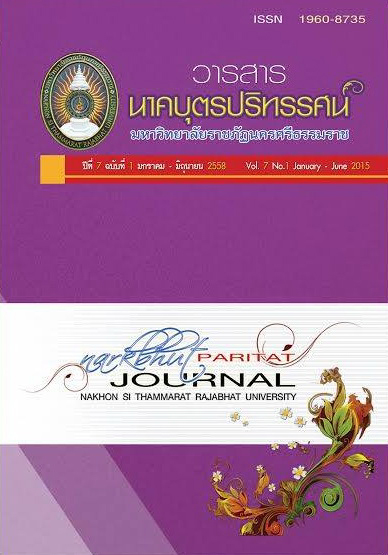บทบาทของผู้บริหารในการสร้างทีมงานเพื่อพัฒนาองค์กร กรณีศึกษาองค์การปกครองส่วนท้องถิ่น อำเภอพรหมคีรี จังหวัดนครศรีธรรมราช
Main Article Content
Abstract
การศึกษาวิจัยครั้งนี้มีวัตถุประสงค์ 1) เพื่อศึกษาและวิเคราะห์บทบาทของผู้บริหารที่ปฏิบัติอยู่จริง (Role Behaviors) 2) เพื่อศึกษาและวิเคราะห์ความสัมพันธ์ระหว่างผู้บริหารกับผู้บริหารด้วยกันในด้านการ สร้างทีมงาน และ 3) เพื่อศึกษาและวิเคราะห์บทบาทของผู้บริหารในการสร้างทีมงาน โดยผู้วิจัยได้ศึกษาจาก กรณีศึกษาองค์การปกครองส่วนท้องถิ่น อำเภอพรหมคีรีจังหวัดนครศรีธรรมราช กลุ่มตัวอย่างที่ทำการศึกษา วิจัยครั้งนี้คือผู้บริหารในองค์การปกครองส่วนท้องถิ่น อำเภอพรหมคีรีจังหวัดนครศรีธรรมราช รวมทั้งสิ้น 64 คน เครื่องมือที่ใช้ในการเก็บรวบรวมข้อมูลคือแบบสอบถาม (Questionnaire) มีเนื้อหาครอบคลุมเกี่ยวกับ ข้อมูล ทั่วไปของผู้บริหารวิธีการบริหารงาน บทบาทของผู้บริหารในการสร้างทีมงานที่มีประสิทธิภาพ ผู้วิจัยได้ดำเนินการ วิเคราะห์ข้อมูลโดยใช้โปรแกรมสำเร็จรูป SPSS สถิติที่ใช้ในการวิเคราะห์ข้อมูลคือ การแจกแจงความถี่ ร้อยละ ค่าเฉลี่ย ส่วนเบี่ยงเบนมาตรฐาน การทดสอบค่าที (independent t-test) และ ANOVA
จากการวิเคราะห์ข้อมูลด้านบุคคลของผู้ตอบแบบสอบถาม พบว่า เพศชายมีสัดส่วนมากกว่าเพศหญิง โดยเพศชายคิดเป็นร้อยละ 59.3 เพศหญิงคิดเป็นร้อยละ 35.2 ผู้บริหารส่วนใหญ่มีอายุระหว่าง 41-50 ปี คิดเป็นร้อยละ 51.9 ส่วนใหญ่ระดับการศึกษาจบปริญญาตรี คิดเป็นร้อยละ 51.9 ตำแหน่งงานส่วนใหญ่อยู่ใน หน่วยกองการศึกษา คิดเป็นร้อยละ 26.9 มีอายุตั้งแต่รับตำแหน่งในระดับผู้บริหารระหว่าง 21-30 ปี คิดเป็น ร้อยละ 87.0 จากการวิเคราะห์ข้อมูลด้านบทบาทหน้าที่ กลุ่มตัวอย่างมีระดับการทำงานเป็นทีมของผู้บริหาร โดยรวมในระดับมาก ค่าเฉลี่ยอยู่ที่ 4.03 (SD=0.72)
เมื่อพิจารณาเป็นรายด้านพบว่าผู้ตอบแบบสอบถามให้ความสำคัญ 2 ลำดับแรกที่มีค่าอยู่ในระดับ มากที่สุด ได้แก่ มีบทบาทให้ความสำคัญในด้านยอมรับฟังความคิดเห็นที่แตกต่าง มีค่าเฉลี่ย 4.31 (SD=0.61) และให้พนักงานมีอิสระในการเสนอความคิดเห็น มีค่าเฉลี่ย 4.30 (SD=0.57) ตามลำดับ จากการทดสอบ สมมติฐานพบว่าระดับการทำงานเป็นทีมของผู้บริหารที่มีช่วงอายุ ระดับการศึกษา ตำแหน่งงาน ช่วงอายุงาน ของผู้บริหารที่แตกต่างกัน ไม่มีผลต่อระดับการทำงานเป็นทีมของผู้บริหาร แต่ระดับการทำงานเป็นทีมของ ผู้บริหารระหว่างเพศชายและหญิงส่งผลต่อระดับการทำงานเป็นทีมของผู้บริหารที่แตกต่างกันอย่างมีนัยสำคัญ ที่ระดับ 0.05
The Roles of the Executive Officers in Team Building: Case Study of Local Administration in Phrom Khiri District, Nakhon Si Thammarat Province.
This study aimed to 1) study and analyze the actual role behaviors of the Executive Officers, 2) study and analyze the relationships among the Executive Officers in team building, and 3) study and analyze the roles of the Executive Officers in team building. The researcher studied from the case study of Local Administration in Phrom Khiri District, Nakhon Si Thammarat Province. The research Data were collected through 64 Executive Officers of Local Administration in Phrom Khiri District, Nakhon Si Thammarat Province by questionnaires. The questionnaires covered the details of general information of the Executive Officers, their management methods, the roles of Executive Officers in efficient team building. The frequencies, percentage, means, standard deviations, independent t-test, and ANOVA were used.
It was found that there were more male than female respondents (59.3 %). Most Executive Officers were 41-50 years old (51.9 %). Most of them gained bachelor’s degree (51.9 %). Most of them worked in education division (26.9 %), with 21-30 years of experiences in the position of the Executive Officers (87.0 %). According to the analysis of roles and duties, it was found that the total level of teamwork of the Executive Officers was at high level with the mean of 4.03 (SD=0.72). When considering into each aspect, it was found that there were 2 most important aspects according to the respondents; namely, open-mindedness with the mean of 4.31 (SD=0.61), and free employees’ points of views allowed with the mean of 4.30 (SD=0.57) respectively. Hypothesis testing found that different ages, education levels, work positions, and work experiences of the Executive Officers did not affect their levels of teamwork. However, there was a statistically significant difference between the levels of teamwork of the Executive Officers with different gender at the 0.05 level of significance.

